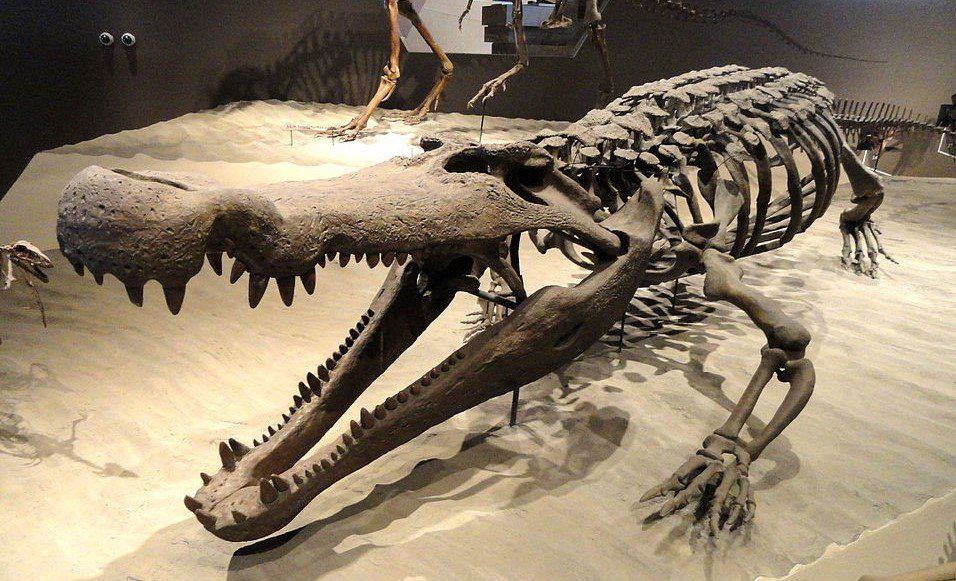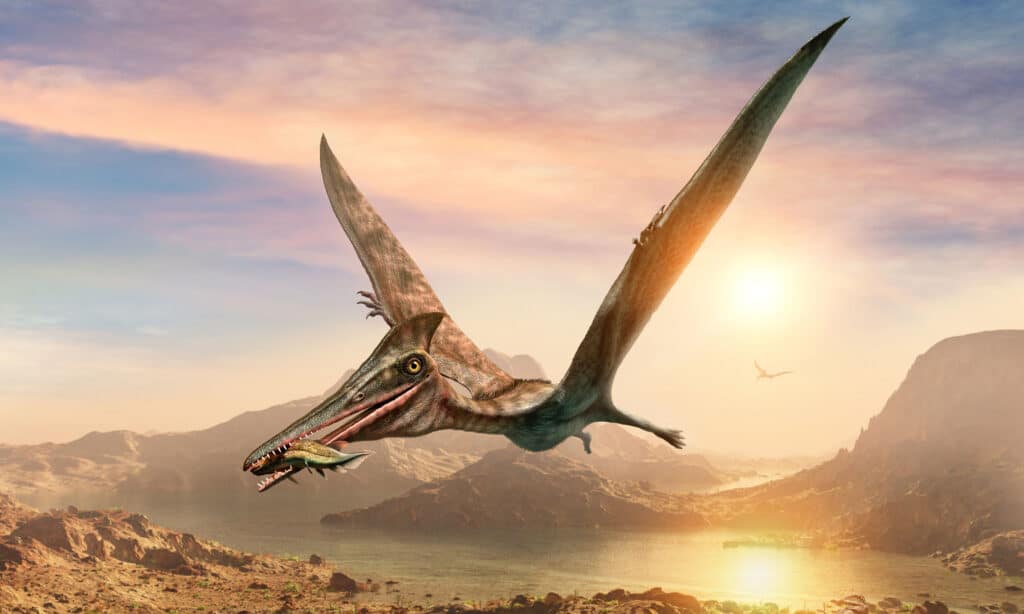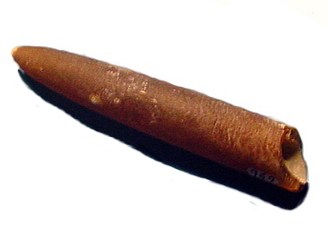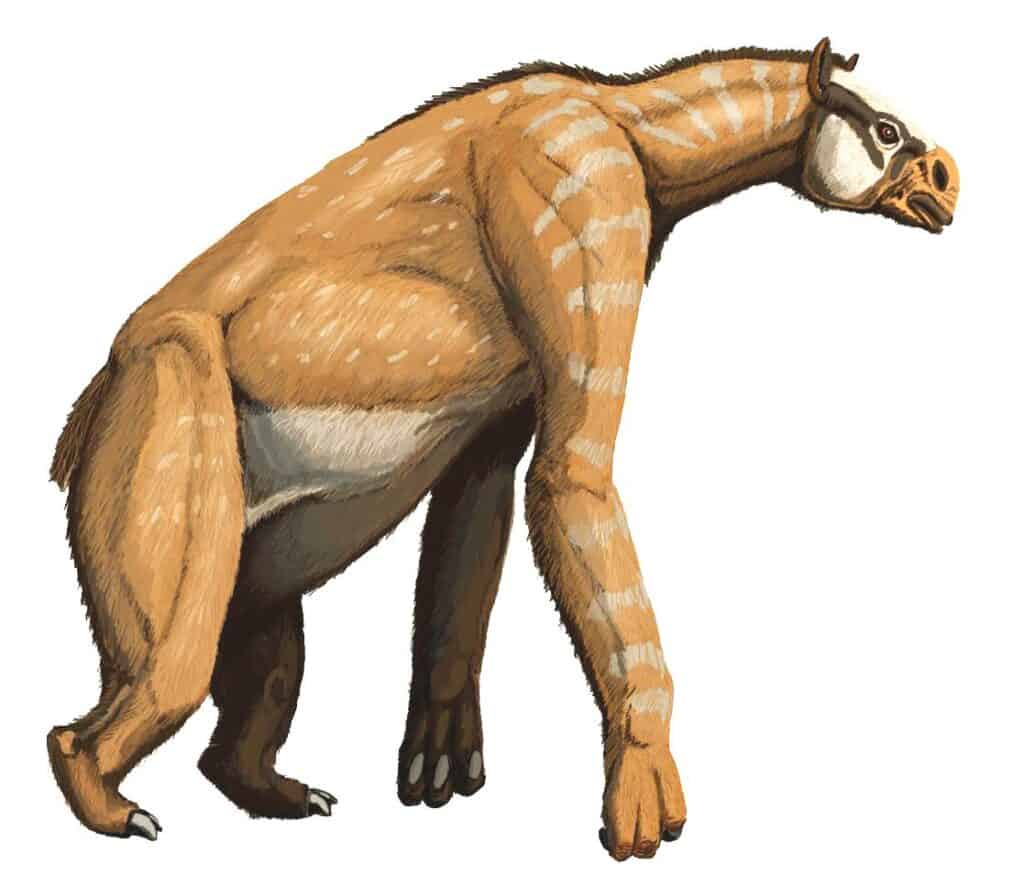Paleontological research is a highly developed field in Delaware. The list of Delaware’s prehistoric life records consists of hundreds of fossils that lived during the Mesozoic and Cenozoic eras. More precisely, we’ll discuss the early and late Cretaceous periods. The Delaware Late Cretaceous dinosaur fossil collection is among the richest in the eastern United States.
When Delaware was transitioning from a terrestrial to a marine environment between the Early and Late Cretaceous, the region was abundant in local marine life, including cephalopods, reptiles, manatees, porpoises, whales, and seals. Cretaceous invertebrates such as crustaceans, annelids, and gastropods, the most common being a crab called Callianassa mortoni, were also found in the area. The terrestrial ecosystems hosted hadrosaurs, pterosaurs, and ornithomimid dinosaurs.
Let’s discuss 5 of these extinct animals that lived in Delaware during the Cretaceous-Paleogene period, including the Delaware state fossil called Belemnitella Americana!
1. Deinosuchus

comes from the Greek words
deinosand
soukhos, meaning “terrible crocodile.”
©Daderot / CC0 1.0 – License
| Deinosuchus | |
|---|---|
| Kingdom | Animalia |
| Phylum | Chordata |
| Class | Reptilia |
| Order | Crocodilia |
| Superfamily | Alligatoroidea |
| Living period | Mesozoic era, the Late Cretaceous period, 82-73 million years ago. |
Deinosuchus comes from the Greek words deinos and soukhos, meaning “terrible crocodile.” It’s an extinct genus in the superfamily Alligatoroidea. The first fossils were found in the 1850s, followed by others in the 1940s.
In 1954, researchers estimated that this crocodile-like animal measured approximately 49 ft. They based their research on a skull of 4.9 ft. A 1999 study says Deinosuchus measured 26 to 33 ft. and weighed 2.8 to 5.5 short tons. There’s still no accurate information about the Deinosuchus’ size, but this animal is considered the largest crocodyliform ever to inhabit Earth. Deinosuchus was believed to have mainly fed on dinosaurs and marine turtles.
Deinosuchus preferred estuarine environments. These animals inhabited many U.S. states, including Delaware. Other states where Deinosuchus fossils have been found are Montana, Wyoming, New Jersey, Texa, Alabama, Georgia, New Mexico, Utah, North Carolina, and Mississippi.
2. Globidens

measured approximately 20 feet long.
©Dmitry Bogdanov / CC BY-SA 3.0 – License
| Globidens | |
|---|---|
| Kingdom | Animalia |
| Phylum | Chordata |
| Class | Reptilia |
| Order | Squamata |
| Superfamily | Mosasauroidea |
| Family | Mosasauridae |
| Tribe | Globidensini |
| Genus | Globidens |
| Living period | Mesozoic era, the Late Cretaceous period, 89.8-66 million years ago |
Globidens is a type of mosasaur lizard. Mosasaurs were a group of marine reptiles that became extinct approximately 66 million years ago. The first mosasaur fossil was discovered in the 1760s. It is believed that they evolved from the Aigialosauridae family of semi-aquatic lizards.
Mosasaurs and Globidens implicitly lived in warm and shallow inland seas and were excellent swimmers. The average mosasaur was 13 feet long. The largest mosasaur, Mosasaurus hoffmannii, grew as long as 56 ft. Globidens precisely measured approximately 20 ft long. They looked like monitor lizards with crescent-shaped flukes on their tails that helped them swim. Globidens fed on small turtles, nautili, ammonites, and bivalves.
Charles W. Gilmore described the first Globidens in the 1910s. Globidens fossils were found in North America, South America, the Middle East, and parts of Africa.
A study shows that the recent discovery of mosasaur specimens found in the Upper Cretaceous deposits of New Jersey and Delaware helped outline the distribution of mosasaurs on the continent.
3. Pterosaur

Pterosaurs are believed to be the first vertebrates that could fly.
©iStock.com/Warpaintcobra
| Pterosaur | |
|---|---|
| Kingdom | Animalia |
| Phylum | Chordata |
| Clade | Ornithodira |
| Clade | Pterosauromorpha |
| Order | Pterosauria |
| Living period | Mesozoic era, from the Late Triassic to the Late Cretaceous, some 228 to 66 million years ago |
Pterosaurs were flying reptiles. They are believed to be the first vertebrates that could fly. The name “pterosaur” is translated as “wing lizard” from the Greek words pteron and sauros.
Pterosaurs can be divided into basal pterosaurs (with long tails) and pterodactyloids (with short tails). People sometimes call them “flying dinosaurs,” but pterosaurs aren’t dinosaurs because they are closely related to birds and reptiles. Dinosaurs are descendants of Saurischia and Ornithischia, while pterosaurs are not part of these two.
Pterosaurs were considered the largest animals that could fly. Their biggest wingspan is 36 ft.
In 1784, Cosimo Alessandro Collini was the first to ever describe a pterosaur fossil. It was one of the most mysterious animals of all time. Researchers weren’t sure how to classify it, where it lived, or whether it was still alive. Later, it was discovered they could fly and were somehow related to birds and bats. Even more, Edward Newman considered them marsupials that could fly.
4. Belemnitella Americana

is a belemnite genus with ten long arms covered with small hooks.
©Luis Miguel Bugallo Sánchez (Lmbuga Commons)(Lmbuga Galipedia) / CC BY-SA 3.0 – License
| Belemnitella Americana | |
|---|---|
| Kingdom | Animalia |
| Phylum | Mollusca |
| Class | Cephalopoda |
| Order | Belemnitida |
| Family | Belemnitellidae |
| Genus | Belemnitella |
| Living period | Mesozoic era, the Late Cretaceous period |
Extinct mollusks that belong to the cephalopod class are called belemnites. It is believed that they are related to modern squids and cuttlefish. They were small, shelled invertebrates, representing marine reptiles’ primary food source.
Belemnitella Americana is a belemnite genus with ten long arms covered with small hooks. Unlike squid, these mollusks had an internal skeleton called a rostrum. The average size of a Belemnitella Americana was 1.5 to 2 inches long.
Belemnites and Belemnitella Americana implicitly had a crucial role in maintaining and restructuring marine ecosystems because many marine animals fed on belemnites. In turn, Belemnitella Americana fed on crustaceans and other mollusks.
Belemnite fossils were abundant along the banks of the Chesapeake and Delaware canals. In 1996, Belemnitella Americana became Delaware’s official fossil.
5. Chalicothere

Chalicothere means “gravel beans” from the Greek
chalixand
therion.
©The original uploader was DiBgd at English Wikipedia / CC BY-SA 3.0 – License
| Chalicothere | |
|---|---|
| Kingdom | Animalia |
| Phylum | Chordata |
| Class | Mammalia |
| Order | Perissodactyla |
| Superfamily | Chalicotheroidea |
| Family | Chalicotheriidae |
| Living period | Cenozoic era, the Paleogene and Neogene periods, around 65.5 to 2.6 million years ago |
Chalicothere means “gravel beans” from the Greek chalix and therion. They were herbivorous mammals in the order of Perissodactyla. Modern members of this order are three living families with around 17 species:
- Family Equidae: horses;
- Family Tapiridae: tapirs;
- Family Rhinocerotidae: rhinoceroses.
Chalicotheres are prehistoric members of Perissodactyla and are divided into:
- The Shizotheriinae: lived in forests, savannahs, and woodlands throughout Africa, Asia, and North and Central America, including Delaware; had long necks and tongues resembling a giraffe; studies show they fed on fruit, twigs, and leaves;
- The Chalicotheriinae lived in moist, closed-canopy forests; they had short necks and long forelimbs. However, this subfamily was never found in America.
The photo featured at the top of this post is © Marti Bug Catcher/Shutterstock.com
Thank you for reading! Have some feedback for us? Contact the AZ Animals editorial team.







